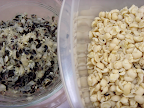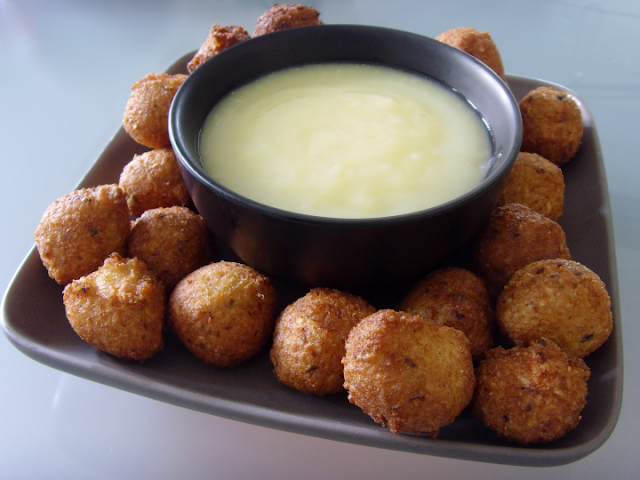Background
Cameroon is a West African country and a former colony of Britain and France. Their major staples are corn, yams, rice, and cassava, and the major protein sources are fish, nuts, and beef
For this week's breakfast, I e-mailed my biology lab teaching assistant from my first semester in college. Chris is a native of Cameroon and is one the most genuine and nice people I have ever met. His enthusiasm and encouragement was a major reason I chose to major in biology. Chris and his wife provided us with a very detailed recipe for akara and corn pap. Akara are deep fried bean fritters made from black-eyed peas and flavored with onion and hot peppers. Corn pap is made with fermented corn starch (homemade from whole, dry corn kernels) and is used as a topping for the akara.
Akara
- 1lb black-eyed peas, soaked overnight.
- 1 tsp salt
- 1 medium onion, finely chopped
- 1 jalapeno, finely chopped (optional)
- 3-4 cups of vegetable oil for frying

- Add beans to blender along with 1 cup of water.
- Chop beans for 30 seconds, then transfer to a large bowl of water.
- Remove the seed coats by agitating the beans with your hands, letting the skins float to the top. Pour off the water and skins. Repeat as necessary.
- Soak for the beans for 3 hours.
- Blend the beans with onion and jalapeno. You want a very thick paste. Add a small amount of water if needed to get the paste consistency.
- Mix in the salt with a fork or mixer. As you do this, keep in mind that you want to add air to the mixture so the akara are fluffy when you fry them.
- Heat oil in a deep pan until moderately hot.(350°F).
- Spoon paste by tablespoons into the hot oil. Allow enough room for movement, doing several batches if necessary.
- Fry, turning frequently until they are golden brown. Ours took about 4 minutes to cook.
- Remove from oil and drain on paper towels.

Corn Pap
Fermenting the cornstarch
- 1 lb whole dried corn kernels (we had good results with a package of yellow samp)
- Wash and soak corn kernels in water for 2-3 days.
- Drain and grind into a very smooth paste.
- Add cold water to the paste, then filter through a fine sieve to remove the husk and larger bits.
- Let the starch solution settle overnight
- The starch can either be used right away or stored in the refrigerator. If you choose to store it in a refrigerator, change the water covering it on a weekly basis.
Making corn pap
- 5 tbsp fermented cornstarch
- 1 cup water
- Sugar to taste
- Mix water and corn starch until they are smooth.
- Place over medium heat and stir constantly to lumps.
- When the mixture starts to boil, add sugar and simmer for 30 seconds.
- Serve with akara.
Results and Discussion
The akara have a nice crunchy exterior and we got a fluffy interior with a falafel-like texture. The corn pap makes a great dipping sauce. It is sweet and slightly sour.
In our first attempt at these last week, our mixture was much too wet because I soaked the skinless beans overnight and added too much water. The wet paste fell apart while frying. The key to making the paste is to error on the side of too dry. We also tried to shallow fry them on our first attempt and this led to lots of sticking and crumbling. Deep oil is needed to get a nice even brown, as it completely submerges them.
Making the corn pap and extracting the corn starch was fun. When you blend the corn kernels and filter them, you get a strainer full of stuff and a white liquid. The starch is in the white liquid and it will settle out overnight. We got about half a cup of starch from a pound of dry corn. I understand why people usually make five pounds at a time if they use lots of the stuff. The fermenting gives it a slightly sour taste. I would be curious to see if you start with normal cornstarch and ferment that (as we have done with some other cereals already), if you would get a similar result with less work.





